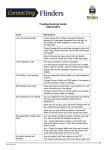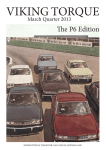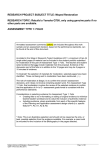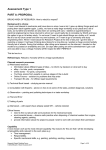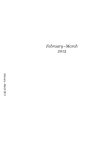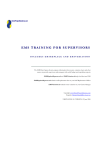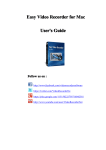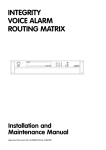Download Repatriation General Hospital Induction Guide
Transcript
FLINDERS UNIVERSITY FACULTY HEALTH SCIENCES BUILDING REPATRIATION GENERAL HOSPITAL An Induction Guide For Students Flinders University, Faculty Health Sciences Building 216 Daws Road, Daw Park SA 5041 Version 1.8 Welcome to the facility site of the Flinders University Faculty of Heath Sciences located at the Repatriation General Hospital. Please note the following contact details for your reference: EMERGENCY PHONE NUMBERS FIRE POLICE AMBULANCE 000 000 000 (Dial O first if calling from inside the building on a landline) Note: telephones in teaching and student rooms do not have external access except for emergency telephone numbers FACILITY WARDENS: Alan Burton RGH Chief Fire Warden/Security (During hours) After Hours Hospital Coordinator (Out of hours) Meredith Legg Warden Room 210 Level 2 Gail Dooley Warden Room 208 Level 2 Debbie Marriott Warden Room 211 Level 2 Andy Messner Warden Room 102 Level 1 Rachel Hutchinson Warden Room 101 Level 1 8275 1153 8275 1236 Ext 18234 Ext 18233 Ext 18235 Ext 18209 Ext 18294 FACILITY FIRST AID OFFICERS: Glenys Clark Amanda Adams Room 101, Level 1 Room 208, Level 2 Ext 18292 Ext 18228 KEY FACILITY STAFF MEMBERS Andy Messner Glenys Clark Rachel Hutchinson Meredith Legg Michael Cox Gail Dooley Kim Devery Jane Stephenson Brenton Kortman Sheila Lennon Safety and Facilities Coordinator Physiotherapy Administrator OT Administrator Student & Business Mgnr Palliative & Supportive Services Faculty FLO support CareSearch Administrator Head Palliative and Supportive Services Nursing lab Manager OT Course Coordinator Head Physiotherapy 2 Ext 18209 Ext 18292 Ext 18294 Ext 18234 Ext 18221 Ext 18233 Ext 18223 Ext 13454 Ext 18287 Ext 18291 CONTENTS CODE OF PROFESSIONAL CONDUCT _____________________________________ 4 GENERAL BUILDING INFORMATION _____________________________________ 5 ACCESS TO THE BUILDING _____________________________________________ 5 EMERGENCY PROCEDURES ____________________________________________ 7 GENERAL SAFETY INFORMATION ______________________________________ 11 FACILITIES ________________________________________________________ 12 REPORTING INCIDENTS OR ACCIDENTS __________________________________ 13 REFERENCE WEBSITES _______________________________________________ 15 BOMB THREAT CHECKLIST ____________________________________________ 16 WHS INDUCTION CHECKLIST __________________________________________ 17 RGH CAR PARKING MAP ______________________________________________ 20 3 CODE OF PROFESSIONAL CONDUCT Purpose To provide a clear statement of the University’s expectations for conduct as a health professional within the educational environment and to promote high standards of conduct within the simulated setting. Flinders University Faculty of Health Sciences expects learners to conduct themselves in a professional manner that will maintain public trust and confidence in the health professions. Code of Professional Conduct All Flinders University Faculty of Health Sciences users must at all times: 1. 2. 3. 4. 5. 6. 7. 8. 9. 10. 11. 12. 13. 14. Practise in a safe and competent manner. Practise in accordance with the agreed standards of their own profession. Practise in a careful, honest and accountable manner in accordance with laws and regulations governing their practice. Work within their scope of practice according to current knowledge and competency standards. Not bring discredit upon the reputation of health professionals. Respect the dignity, culture, values and beliefs of all individuals. Comply with the Constitution, Regulations, Policies and Procedures governing their practice. Promote and preserve the trust inherent in the privileged relationship between a practitioner and an individual, and respect both the person and property of that individual. Treat all scenario information and co-participant performances, in a professional capacity as confidential. Strive to use all given learning opportunities to their maximum potential by being prepared, participating to the best of their abilities and working constructively within the simulated team. Communicate and co-operate with colleagues and facilitators in a professional manner. Conform to professional expectations with regard to appearance punctuality and attire. Ensure training areas and equipment are maintained in accordance with Occupational Health Safety Standards and report any ‘near misses’, incidents or faulty equipment to a staff member immediately. Give honest feedback to Flinders University Faculty of Health Sciences via a post training evaluation form, promoting continuous improvement and quality. 4 GENERAL BUILDING INFORMATION It is important that you are aware of the Emergency Evacuation Procedures which have been put in place for your safety in the event of a Fire or Emergency in the building. Prepare yourself for the possibility that an emergency evacuation may occur by making yourself familiar with the Exit signs and Exit doors and the nominated Assembly Area. ACCESS TO THE BUILDING The Faculty of Health Sciences Building at the Repatriation General Hospital (RGH) is located on Daws Road (refer to RGH map in the appendix, the building is referred to as no 26 on the map), directly opposite the Pasadena High School oval with foot entrance through gate 5. If you park in the RGH site the entrance to the car parks is off Goodwood Road. For security purposes, it is important that you have your University ‘Student ID’ or 'Staff ID' with you when attending the site. The Faculty of Health Sciences building is secured by an electronic access system. The building is locked between 5:30pm and 8:00am on weekdays. To gain after-hours access, (up to 10:00pm on a week day) see Reception staff to complete an ‘After-hours access form’. Security at Flinders will require at least 24 hours notice in which to provide access to you via your Flinders University library ID card. Before students are provided access to the building they must complete an Access Control System Authorisation form available from Glenys Clark and Rachel Hutchinson (Reception). All movement in the building is monitored by video and logged by swipe card access. Repatriation General Hospital (RGH) Security has been issued with a master key and a swipe card access to the building. If authorized staff or students are locked out of the building or office, where personal belongings are left inside (i.e. swipe card and/or key) and require access, they are to contact RGH Security in the first instance. The RGH Security has permission to access the building and accompany the person onto the premises where ID has or can be presented or verified. If a person requires access who cannot present their FU ID (staff or student), they will not be given access to the building. Staff and students using the facilities after 9:00pm are to advise RGH Security they are in the building and an approximate time of departure. RGH Security is requested to email or phone through during business hours to the Safety & Facilities Coordinator, Andy Messner ([email protected] or 7221 8209) where after-hours access has been requested. Children on University Premises In accordance with university guidelines, children on university premises must be under the direct supervision of a responsible adult at all times. 5 Parents/carers may request approval to bring their children to work, classes or study areas where there are sudden and/or unexpected difficulties with childcare arrangements. Approval should be obtained from a supervisor/lecturer for the child to attend work/classes/study areas. The University expects that parents will not routinely bring children to work, classes or study areas as an alternative to organised childcare. Parents/carers must ensure that children do not disrupt academic or general work or student activities. The University reserves the right to direct that a child be removed from University premises where the presence of the child is causing an unacceptable health and safety risk or an unreasonable level of disruption to others. Emergency Exits Continuously illuminated Exit signs identify emergency exit locations from all sections within the building. All emergency exits lights are battery backed and during power failure, all of the exit signs will remain illuminated for at least 90 minutes. Emergency Lighting Emergency lighting is installed in strategic places throughout the building. In the event of failure of the mains power supply, the emergency lights should activate almost instantaneously for a short period. First Aid Kits The First Aid Kits are located in the Clinical Skills Lab (in room 109) on the level 1 and on level 2 near the male toilets opposite room 203. Air Conditioning The building’s ducted air conditioning system will shut down automatically on the operation of the Fire Alarm. Ceiling Installed Sprinkler System Sprinkler system will automatically activate if sensors record high heat. Emergency Evacuation Plan Copies are displayed at various points throughout the building, including: Ground floor opposite Reception Ground floor end of northern corridor outside the Student Computing Room First floor outside main copier room First floor at end of northern corridor. Emergency Evacuation Assembly Area GRASSED AREA AT THE SOUTH EASTERN END OF THE BUILDING. You must remain in the assembly area until the situation is stabilised. Under no circumstances will you be permitted to go back into the building for any reason, until advised safe to do so by the Chief Warden or the Emergency Services Officer in Charge. 6 Fire Alarm The building is equipped with an AUTOMATIC fire detection and alarm system, which is connected directly to SA Metropolitan Fire Service. Manual call points are also located throughout the building: These fire system components must remain unobstructed at ALL times. Activation of the alarm will: 1. Alert tone will sound (BEEP, BEEP) throughout the building. 2. Evacuation tone will sound (high low – WOOP, WOOP) The Fire Service will then be summoned. Identification To be easily recognisable in the event of an emergency, the Fire Wardens will wear red fluoro vests. EMERGENCY PROCEDURES The following procedures relate to onsite at the Repatriation General Hospital. Please note these are different to Flinders University Campus During an emergency: Stay Calm Stop - Assess - Act Ask yourself - what has happened? Can I be injured? TO DIAL EMERGENCY PRESS BUTTON TO THE RIGHT OF ‘EMERGENCY ONLY’ ON ANY TELEPHONE 7 In the event of CARDIAC ARREST or OTHER MEDICAL EMERGENCY: 1) ASSESS THE SITUATION: Check for DANGER 2) ASSESS THE PATIENT: Check for RESPONSE - unconscious? CALL FOR HELP in immediate area (ring Emergency Bell, or call out) Check AIRWAY – look for signs of life Check BREATHING Check CIRCULATION MEDICAL EMERGENCY On landline phones PRESS BUTTON TO THE RIGHT OF ‘EMERGENCY ONLY’ and state “CODE BLUE” and LOCATION of emergency If no signs of life (unconscious, unresponsive, not breathing normally, not moving), commence resuscitation of patient: AIRWAY – clear and open the airway; BREATHING – if not breathing normally, give two initial breaths; CIRCULATION – give 30 chest compressions (almost 2 compressions per second), followed by 2 breaths. Upon arrival of emergency team: Continue CPR Follow instructions of emergency team members If you discover a fire: Remove anyone in immediate danger of the fire/smoke, and call for assistance. On landline phones PRESS BUTTON TO THE RIGHT OF ‘EMERGENCY ONLY’ and state “CODE RED – FIRE”, and give the LOCATION and nature of the fire, their name and position; OR ACTIVATE a manual call point (break glass alarm). FIRE FIGHT the fire with the appropriate extinguisher, if trained in its operation. If the fire gets beyond the control of an extinguisher, withdraw, closing doors (and windows) if safe to do so. Await the arrival of the Emergency Response Team, which will assist in fire fighting, or evacuation if necessary. SMOKE: A person discovering a smell of smoke shall IMMEDIATELY: On landline phones PRESS BUTTON TO THE RIGHT OF ‘EMERGENCY ONLY’ and state “CODE RED – SMOKE”, and give their name and LOCATION. Await the arrival of the Emergency Response Team, which will investigate all reports. REPORT all smoke smells - do not treat the smell of smoke as trivial. 8 An INTERNAL EMERGENCY can arise through FAILURE of vital internal services, or from THREATS to vital internal services and others. SUBSTANTIAL LOSS OF POWER, WATER, GAS, STEAM, COMMUNICATIONS OR MEDICAL GASES On landline phones PRESS BUTTON TO THE RIGHT OF ‘EMERGENCY ONLY’ and report type and location of emergency. HAZARDOUS SUBSTANCE SPILLAGE (includes flammable liquids, and corrosive, toxic, biological and radioactive substances) • • INTERNAL EMERGENCY • • Establish what has been spilt. On landline phones PRESS BUTTON TO THE RIGHT OF ‘EMERGENCY ONLY’ and report location of spill and substance name. Evacuate immediate vicinity and close doors. Await arrival of Emergency Response Team/emergency services and advise all details. GAS LEAK / TOXIC SMELL • • • On landline phones PRESS BUTTON TO THE RIGHT OF ‘EMERGENCY ONLY’ and report location and nature of leak/smell. If necessary, evacuate area and close doors and fire doors. Await arrival of Emergency Response Team/emergency services. DENSE SMOKE OR HAZARDOUS AIRBORNE POLLUTION OUTSIDE • • Close, and if necessary seal, windows, doors and other entry points On landline phones PRESS BUTTON TO THE RIGHT OF ‘EMERGENCY ONLY’ and report location so that air conditioning systems can be shut off. Treat the caller as GENUINE. ALERT someone else if possible. RECORD all information. USE the Bomb Threat Checklist over the page, or in the Internal Telephone Directory. 1) Keep the caller talking. ASK questions as per Checklist: about type and location of bomb, reasons for its placement, when it will detonate. BOMB THREAT 2) Note all details possible: male/female, accent, background noises, etc. 3) DO NOT disconnect the call, i.e. do not replace the phone on the hook after the caller has hung up. On landline phones PRESS BUTTON TO THE RIGHT OF ‘EMERGENCY ONLY’ to notify Switchboard as soon as possible of bomb threat. Notify your Warden/Supervisor. Complete Checklist as much as possible. 9 Keep information CONFIDENTIAL, remain in area, and await arrival of Bomb Threat Response Team. DO NOT evacuate on the notification of a bomb threat until instructed by the Hospital Controller or other member of Bomb Threat Response Team. If bomb is found, or an object is located which raises suspicion because it is out of place, or it doesn’t belong in the area, or it cannot be identified, or its ownership cannot be identified: DO NOT TOUCH IT. DO NOT MOVE IT. CLEAR all people away from immediate area. Isolate it. Conspicuously MARK its location, e.g. paper trail to nearest exit. NOTIFY the Hospital Controller of the find. In the event of an emergency/disaster occurring OUTSIDE the hospital the Hospital Controller will declare the EXTERNAL EMERGENCY plan active. EXTERNAL EMERGENCY Staff with specific duties in such a disaster shall follow the instructions in the hospital’s EMERGENCY MANUAL, section ‘Code Brown: External Emergency’. All other staff to continue normal duties unless directed to assist in another area. REMAIN in your area to avoid confusion in areas concerned with the emergency. Avoid non-essential use of internal and external telephone lines. Evacuate only if: Smoke or flame from a fire; a chemical spill; a gas leak; or toxic fumes in your work area, makes it necessary. OR You are directed to by your Warden, or Leader of an Emergency Response Team, or by the Fire Service. DO NOT evacuate on the notification of a bomb threat until instructed by the Emergency Response Team Leader. EVACUATION Move people from the problem area to a safe area, in following order: FIRST * Most endangered SECOND * Ambulant/semi-ambulant LAST * Fully dependent Follow the evacuation plan for your area. Evacuate to designated ASSEMBLY AREA, or to an area advised by your Warden/Response Team Leader/Supervisor/Fire Service. If possible, Wardens/nurses to check that all rooms are vacated. Close doors and windows (EXCEPT in a bomb threat situation, when they are to be left open to assist in venting any possible explosion). Where possible, the ‘Room Checked’ tags are to be placed on the exterior of doors. 10 GENERAL SAFETY INFORMATION For general building after-hours information or assistance, contact numbers are: Repatriation General Hospital - Security RGH Security Guards Flinders University - Security 8275 1244 0432 753 626 Ext 12880 Safe Operating Procedures (SOP) A SOP is a written procedure that describes the hazards and risks associated with a specific task and exactly how a particular job or task is to be carried out. It contains details of the various components of the job or task listed in a logical sequence from beginning to end. In addition an SOP describes how each component can be carried out safely in order to prevent injury and illness. Copies of Safe Operating Procedures are placed in the respective areas for your benefit. Please familiarise yourself with the correct procedures before commencing any task. Mobility / other impaired persons in the building Persons suffering from mobility impairment or other impairment that would impact on their safe and speedy evacuation have an obligation to communicate the nature of the impairment to their warden prior to any event, which may require the impaired person’s evacuation. There is a car parking located outside C block for disabled persons. Persons in charge of a class In the absence of wardens the person in charge of a class may be required to take control of the complete situation and assume the warden’s role until relieved. Communications Please try to avoid using the phone to contact family or friends during an emergency as over-loaded lines can block out vital communication links with the emergency services. Security in Car Park Lock vehicles left in the Repatriation General Hospital car park and close all windows. Do not leave any valuables or expensive equipment in vehicles in open view. All vehicles parked on the RGH site is at the owner’s risk and responsibility. The RGH accepts no responsibility for loss or damage to vehicles parked in the Hospital grounds. Working Alone or After Hours Students are responsible for taking all reasonably practical steps to ensure their own safety and security when working alone or after hours. Students should not work alone in areas where there is risk of: • Asphyxiation • Unconsciousness • Entrapment • Amputation • Electrocution • Entanglement No individual, who has a known medical condition that may rise to a life threatening situation may work after hours or alone without notifying his or her supervisor of the condition and with an appropriate management plan documented and agreed too. 11 Use of Computers All Flinders students have access to the Student Computer Room 8:00am – 8:00pm Monday to Friday. A Flinders Authentication Number (FAN) is required to login to the computers ensuring access to systems and printing. In order to print from the Student Computing Room students will need to ensure there is credit on their Flinders University library account. You will also need to activate your FAN before you will have access to the Internet. For Student computing and printing faults contact Reception in the first instance. For further assistance contact Unicard ext 13413. For computing faults contact IT Helpdesk on ext 12345. Student Lockers Lockers are available for the safe storage of personal items such as backpacks, wallets, the interests of OHS&W, perishable items are not to be stored in lockers. purses etc. In Locker Access To obtain a locker please register with Reception. Lockers are available for the duration of one semester only. There is no hire charge. Students are responsible for providing their own locks. At the end of each semester all lockers must be vacated. Any locks remaining on lockers after the end of a semester (30th June and 31st Dec) will be removed. If you require an extension after these due dates please contact Glenys Clark. The University shall not in any way be liable or responsible for any loss of, or theft of, or damage to, any property which is left in the lockers at any time. FACILITIES Toilets The building is equipped with toilet facilities with female and disabled/unisex persons on level 1 and male toilets on level 2. Student Kitchen /Common Room This area is equipped with a microwave, fridge, hot and cold water on tap for the use of students. Please clean appliances after use and dispose of all rubbish including recyclables. RGH Cafes There are three cafes on the RGH site. The Springbank cafe is located in between A Block and Rehabilitation buildings. The Volunteers coffee shop is located next to the Outpatients, Repat Clinics, (refer to RGH map at the end of this guide, appendix 2). The new ViTA building on the northern side of the Repat has a café on the ground floor. Bike Racks The nearest undercover Bike Rack to the building is located at the northern end of B Block. Under no circumstances are bikes permitted inside the building. There are also bike racks located between this building and C Block at the northern end. Access to Car Park Please refer to the attached map of the RGH parking areas at the end of this guide, appendix 1. Please note that car parking fees apply at RGH. To park onsite at RGH you will need a permit which 12 can be purchased from the Cashier’s Office in A Block. Application forms for student car parking permit are available from the Reception in the Health Sciences Building. Temporary car park permits for students are $11 per week, which enable you to park in any of the staff car parks. Visitor & Patient Parking – This is for visitors and patients to the RGH only. (Fines will apply when caught) Staff Parking – This is for Staff and students with valid RGH parking permits. Motorbike Parking – This is for Motorcycles only and is an initiative to stop the practice of motorbikes being parked on pathways around building and particularly in ‘car’ parks. (Fines will apply when caught). Bicycle Parking – in between the HSBuilding and C Block there are limited Bicycle parking as well as undercover parking by the new 4th Gen Building, no scooters. Blue Parking Permits – Specialist parking only. Access to Public Transport Buses to Flinders University campus and to the city are available on Goodwood Road. The bus stops are approximately a 5 minute walk from the Faculty of Health Sciences building. Below is the website for Adelaide Metro which provides timetables and bus and train routes. http://www.adelaidemetro.com.au/ Hospital Access Please familiarise yourself with the Repatriation General Hospital site, including all entry and exists. A map of the hospital is attached at the end of this guide, appendix 2. Non Smoking Smoking is prohibited in all areas of the building and on the hospital site. Alcohol No person shall, without the permission of the Flinders University Council or its delegate, bring any alcoholic liquor upon the University grounds, or keep or consume any alcoholic liquor upon the University grounds. REPORTING INCIDENTS OR ACCIDENTS Reporting of Security Incidents Report all security incidents or theft of private property on the University’s premises to your Supervisor or the Facilities Administrator – reports should be made at the earliest possible time and will be treated confidentially. If you are disturbed or concerned on weekends or afterhours by person's loitering around the building or skateboarding on the building pathways, please notify either the building receptionist or facility administrator as soon as practicable. Reporting an Accident or Incident All accidents and incidents must be immediately reported to the Supervisor of the person concerned and to the Facilities Administrator. 13 The person involved in the accident must complete an "Accident/Incident Report Form" as soon as practicable. Reporting of accidents or incidents are done through the FlinSafe portal via the Flinders University Work Health and Safety webpage http://www.flinders.edu.au/whs/ Where, due to the accident, the person concerned is unable to complete an Accident/Incident Report Form via FlinSafe portal then arrangements must be made for his or her Supervisor to complete the form. The online forms must be completed no later than 24 hours after the accident/incident. Enquiries and Assistance Please see Administrative staff at the Reception Desk if you wish to speak to a particular staff member or require assistance in some way. 14 REFERENCE WEBSITES Flinders University Website http://www.flinders.edu.au/ Student Related Policies and Procedures: http://www.flinders.edu.au/ppmanual/student.html Flinders University Library http://www.flinders.edu.au/library/ Flinders University Campus http://www.flinders.edu.au/campus/ Student appeals, complaints and grievances http://www.flinders.edu.au/current-tudents/policies-procs/rights/student-appeals-complaints-andgrievances.cfm Overview of Student Rights and Responsibilities http://www.flinders.edu.au/current-students/policies-procs/rights/rights_home.cfm FlinSafe Portal for reporting incidents or accidents http://www.flinders.edu.au/whs/flinsafe/welcome-to-flinsafe.cfm OHS&W Unit for information on Policies, procedures, forms etc http://www.flinders.edu.au/ohsw/ Flinders University Faculty of Health Sciences Website http://www.flinders.edu.au/health-sciences/ Repatriation General Hospital http://www.rgh.sa.gov.au/ 15 BOMB THREAT CHECKLIST Remember: keep calm Don’t hang up your telephone QUESTIONS TO ASK 1. When is the Bomb going to explode? 2. Where did you put the Bomb? 3. When did you put it there? 4. What does the Bomb look like? 5. What will make the Bomb explode? 6. What kind of Bomb is it? 7. Did you place the Bomb? 8. Why did you place the Bomb? 9. What is your name? 10. Where are you? 11. What is your address? WRITE DOWN EXACT WORDING OF THREAT: 16 WHS INDUCTION CHECKLIST FOR FACULTY OF HEALTH SCIENCES BUILDING REPATRIATION GENERAL HOSPITAL & PASADENA HIGH SCHOOL Name: Program Start Date: Please complete all applicable sections of the Checklist below. when done Emergency and First Aid Procedures Advised of procedures & sounds for emergency evacuation and location of assembly area Shown location of building plan, emergency exits and fire extinguishers Introduced to area Fire Wardens and contact details for same Advised of first aid procedures and location of first aid persons Informed of Security procedures on campus (access to building, telephones, RGH Security) Forms Yes Access Control System Authorisation Form Occupational Health & Safety Provided with contact details of area Health & Safety Representative Shown location of University OHS website Explained relevant Safe Operating Procedures and location Repetitive work (including word processing and data entry) Manual Handling Advised of responsibility to report hazards to supervisor/lecturer for risk assessment & control Informed of Accident/Incident Forms via FlinSafe portal Location and use of conveniences (toilets, kitchen, showers, bike rack) Building Facilities Access to car park List of relevant staff contact details Pasadena High School Informed of Staff/Students/Visitor Sign in book Informed of Wearing Identification at ALL TIMES Informed or Operating Hours Facilities Administrator to retain all signed sheets Signed (Supervisor/Facilities Admin) Date Signed (Staff/Student) Date 17 N/A Version 1.8 19



















